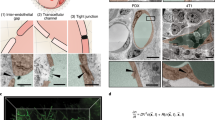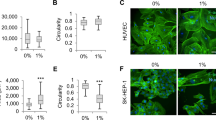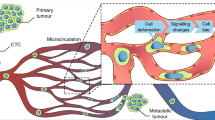Abstract
Enhanced permeability in tumours is thought to result from malformed vascular walls with leaky cell-to-cell junctions1,2. This assertion is backed by studies using electron microscopy and polymer casts that show incomplete pericyte coverage of tumour vessels and the presence of intercellular gaps3. However, this gives the impression that tumour permeability is static amid a chaotic tumour environment. Using intravital confocal laser scanning microscopy4,5 we show that the permeability of tumour blood vessels includes a dynamic phenomenon characterized by vascular bursts followed by brief vigorous outward flow of fluid (named ‘eruptions’) into the tumour interstitial space. We propose that ‘dynamic vents’ form transient openings and closings at these leaky blood vessels. These stochastic eruptions may explain the enhanced extravasation of nanoparticles from the tumour blood vessels, and offer insights into the underlying distribution patterns of an administered drug6,7.
This is a preview of subscription content, access via your institution
Access options
Subscribe to this journal
Receive 12 print issues and online access
$259.00 per year
only $21.58 per issue
Buy this article
- Purchase on Springer Link
- Instant access to full article PDF
Prices may be subject to local taxes which are calculated during checkout




Similar content being viewed by others
References
Hashizume, H. et al. Openings between defective endothelial cells explain tumor vessel leakiness. Am. J. Pathol. 156, 1363–1380 (2000).
Matsumura, Y. & Maeda, H. A new concept for macromolecular therapeutics in cancer chemotherapy: mechanism of tumoritropic accumulation of proteins and the antitumor agent smancs. Cancer Res. 46, 6387–6392 (1986).
Li, Y. et al. Direct labeling and visualization of blood vessels with lipophilic carbocyanine dye DiI. Nature Protoc. 3, 1703–1708 (2008).
Matsumoto, Y. et al. Direct and instantaneous observation of intravenously injected substances using intravital confocal micro-videography. Biomed. Opt. Express 1, 1209–1216 (2010).
Nomoto, T. et al. In situ quantitative monitoring of polyplexes and polyplex micelles in the blood circulation using intravital real-time confocal laser scanning microscopy. J. Control. Release 151, 104–109 (2011).
Cabral, H. et al. Accumulation of sub-100 nm polymeric micelles in poorly permeable tumours depends on size. Nature Nanotech. 6, 815–823 (2011).
Jain, R. K. & Stylianopoulos, T. Delivering nanomedicine to solid tumors. Nat. Rev. Clin. Oncol. 7, 653–664 (2010).
Lee, H., Fonge, H., Hoang, B., Reilly, R. M. & Allen, C. The effects of particle size and molecular targeting on the intratumoral and subcellular distribution of polymeric nanoparticles. Mol. Pharm. 7, 1195–1208 (2010).
Matsumoto, K. et al. Study of normal and pathological blood vessel morphogenesis in Flt1-tdsRed BAC Tg mice. Genesis 50, 561–571 (2012).
Dvorak, H. F., Nagy, J. A., Dvorak, J. T. & Dvorak, A. M. Identification and characterization of the blood vessels of solid tumors that are leaky to circulating macromolecules. Am. J. Pathol. 133, 95–109 (1988).
Ruggeri, B. A., Camp, F. & Miknyoczki, S. Animal models of disease: pre-clinical animal models of cancer and their applications and utility in drug discovery. Biochem. Pharmacol. 87, 150–161 (2014).
Tsuzuki, Y. et al. Pancreas microenvironment promotes VEGF expression and tumor growth: novel window models for pancreatic tumor angiogenesis and microcirculation. Lab. Invest. 81, 1439–1451 (2001).
Stirland, D. L., Nichols, J. W., Miura, S. & Bae, Y. H. Mind the gap: a survey of how cancer drug carriers are susceptible to the gap between research and practice. J. Control. Release 172, 1045–1064 (2013).
Holback, H. & Yeo, Y. Intratumoral drug delivery with nanoparticulate carriers. Pharm Res 28, 1819–1830 (2011).
Kumar, A. & Graham, M. D. Mechanism of margination in confined flows of blood and other multicomponent suspensions. Phys. Rev. Lett. 109, 108102 (2012).
Lee, S. Y., Ferrari, M. & Decuzzi, P. Design of bio-mimetic particles with enhanced vascular interaction. J. Biomech. 42, 1885–1890 (2009).
Lee, S. Y., Ferrari, M. & Decuzzi, P. Shaping nano-/micro-particles for enhanced vascular interaction in laminar flows. Nanotechnology 20, 495101 (2009).
Mitragotri, S. & Lahann, J. Physical approaches to biomaterial design. Nature Mater. 8, 15–23 (2009).
Wong, C. et al. Multistage nanoparticle delivery system for deep penetration into tumor tissue. Proc. Natl Acad. Sci. USA 108, 2426–2431 (2011).
Baron, V. T., Welsh, J., Abedinpour, P. & Borgstrom, P. Intravital microscopy in the mouse dorsal chamber model for the study of solid tumors. Am. J. Cancer Res. 1, 674–686 (2011).
Schneider, C. A., Rasband, W. S. & Eliceiri, K. W. NIH Image to ImageJ: 25 years of image analysis. Nature Methods 9, 671–675 (2012).
Weller, H. G. & Tabor, G. A tensorial approach to computational continuum mechanics using object-oriented techniques. Comput. Phys. 12, 620–631 (1998).
Issa, R. I. Solution of the implicitly discretised fluid flow equations by operator-splitting. J. Comput. Phys. 62, 40–65 (1985).
Hobbs, S. K. et al. Regulation of transport pathways in tumor vessels: role of tumor type and microenvironment. Proc. Natl Acad. Sci. USA 95, 4607–4612 (1998).
Boucher, Y. & Jain, R. K. Microvascular pressure is the principal driving force for interstitial hypertension in solid tumors: implications for vascular collapse. Cancer Res. 52, 5110–5114 (1992).
Levick, J. R. & Michel, C. C. Microvascular fluid exchange and the revised Starling principle. Cardiovasc. Res. 87, 198–210 (2010).
Stohrer, M., Boucher, Y., Stangassinger, M. & Jain, R. K. Oncotic pressure in solid tumors is elevated. Cancer Res. 60, 4251–4255 (2000).
Acknowledgements
We would like to thank D. Stirland for providing the code used to perform distance to GFP analysis. This work was supported by the Core Research Program for Evolutional Science and Technology (CREST) and Center of Innovation (COI) Program from the Japan Science and Technology Corporation (JST), the Funding Program for World-Leading Innovative R&D on Science and Technology (FIRST Program) from the Japan Society for the Promotion of Science (JSPS), KAKENHI Grant Numbers 2379004 (Y.M.), 15K06871 (K.T.), 25750172 (H.C.), 24659584 (Y.M.), and 25000006 (K.K.) from the Japanese Ministry of Education, Culture, Sports, Science and Technology (MEXT) of Japan, the Research Foundation for Pharmaceutical Sciences (Y.M.), the Photographic Research Fund of the Konica Minolta Imaging Science Foundation (Y.M.), and Grants from the Initiative for Accelerating Regulatory Science in Innovative Drug, Medical Device, and Regenerative Medicine of the Ministry of Health, Labour and Welfare (MHLW) of Japan. Funding for this work from J.N. and Y.H.B. was provided in part by NIH CA122356.
Author information
Authors and Affiliations
Contributions
Y.M. conceived, designed, and performed IVCLSM experiments, analysed the data, and wrote the paper. J.N. designed and performed computer simulation experiments, analysed the data, and wrote the paper. Y. Matsumoto and J.N. contributed equally to this work. K.T. and T.N. assisted with IVCLSM experiments. H.C., Y. Miura, and N.Y. synthesized the fluorescent nanoparticles. T.O. customized the microscope and maintained it in excellent condition. All authors discussed the results and commented on the manuscript. H.C., N.N., Y.H.B. and K.K. edited the manuscript. Y.H.B. and K.K. supervised the whole project.
Corresponding authors
Ethics declarations
Competing interests
T.O. is an employee of Nikon Instech Co., Ltd., Japan. All other authors declare no competing financial interest.
Supplementary information
Supplementary information
Supplementary information (PDF 882 kb)
Supplementary information
Supplementary Movie 1 (MOV 20171 kb)
Supplementary information
Supplementary Movie 2 (MOV 12279 kb)
Supplementary information
Supplementary Movie 3 (MOV 1128 kb)
Rights and permissions
About this article
Cite this article
Matsumoto, Y., Nichols, J., Toh, K. et al. Vascular bursts enhance permeability of tumour blood vessels and improve nanoparticle delivery. Nature Nanotech 11, 533–538 (2016). https://doi.org/10.1038/nnano.2015.342
Received:
Accepted:
Published:
Issue Date:
DOI: https://doi.org/10.1038/nnano.2015.342
This article is cited by
-
Breaking through the basement membrane barrier to improve nanotherapeutic delivery to tumours
Nature Nanotechnology (2024)
-
B7H3 targeting gold nanocage pH-sensitive conjugates for precise and synergistic chemo-photothermal therapy against NSCLC
Journal of Nanobiotechnology (2023)
-
Theranostic applications of selenium nanomedicines against lung cancer
Journal of Nanobiotechnology (2023)
-
Skin cancer: understanding the journey of transformation from conventional to advanced treatment approaches
Molecular Cancer (2023)
-
Dendritic cell hybrid nanovaccine for mild heat inspired cancer immunotherapy
Journal of Nanobiotechnology (2023)



